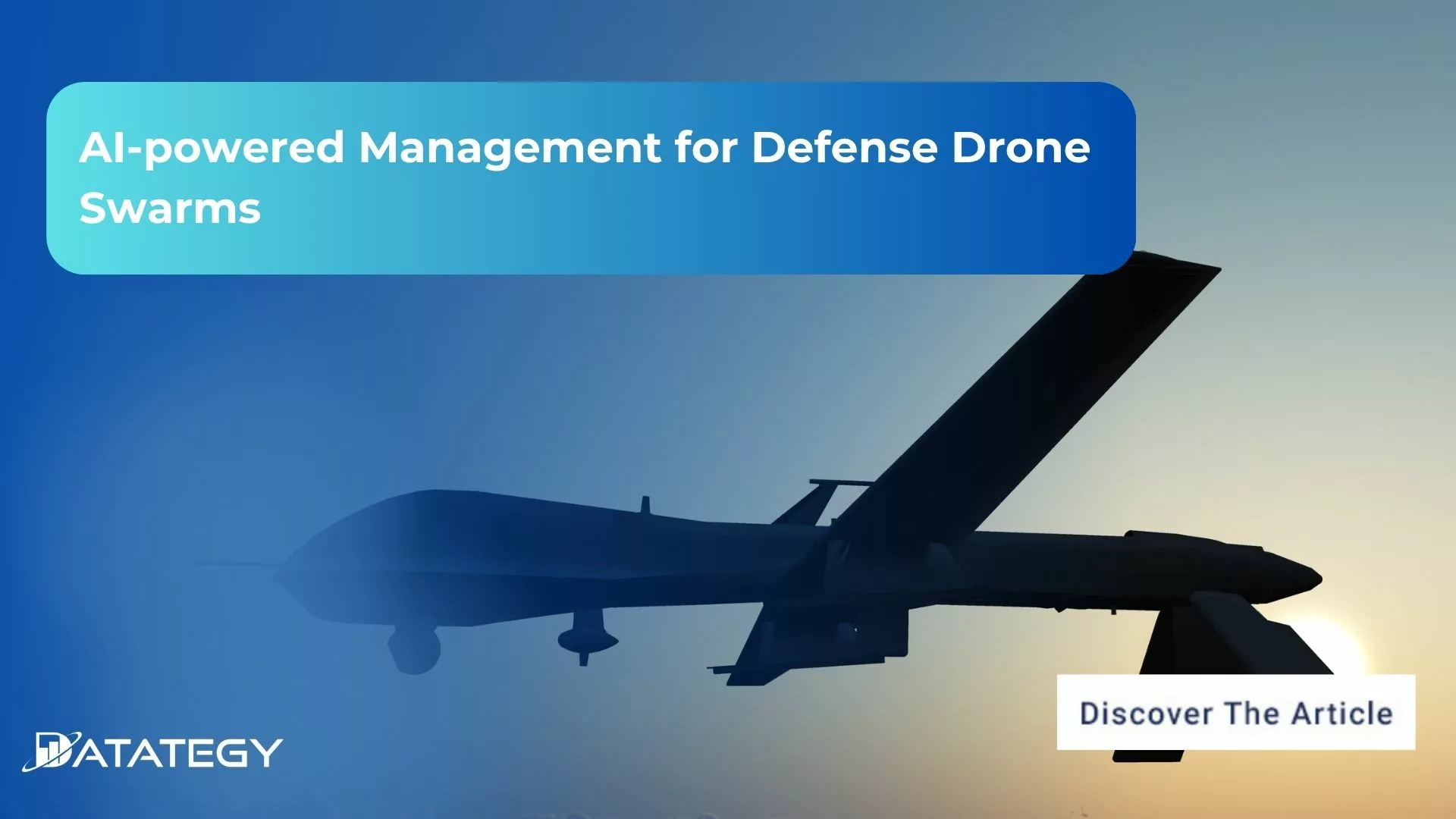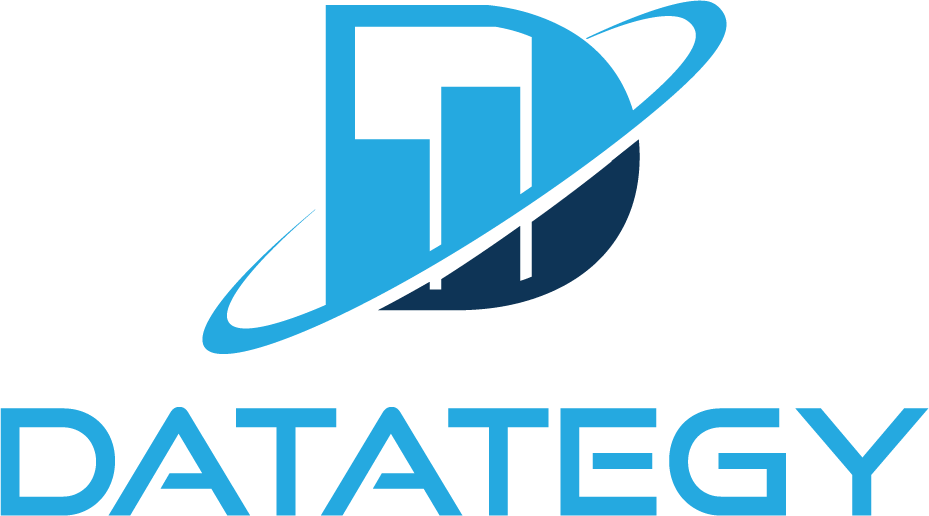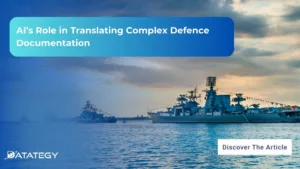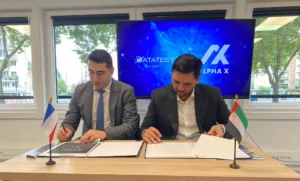We Don’t Just Build AI, We Deliver Measurable Impact Join...
Read MoreAI-powered Management for Defense Drone Swarms
Table of Contents
ToggleDrones are now a key part of modern combat. They have changed the battlefield and play an important role on the front lines. Military operations have evolved because drones have moved from simple reconnaissance tools to flexible platforms. These platforms can perform precise strikes and offer logistical support.
But the real revolution is where drone technology and artificial intelligence (AI) meet, especially when it comes to drone swarms. This combination has the potential to revolutionize future warfare by bringing capabilities to previously unheard-of heights and establishing a new offensive and defensive paradigm.
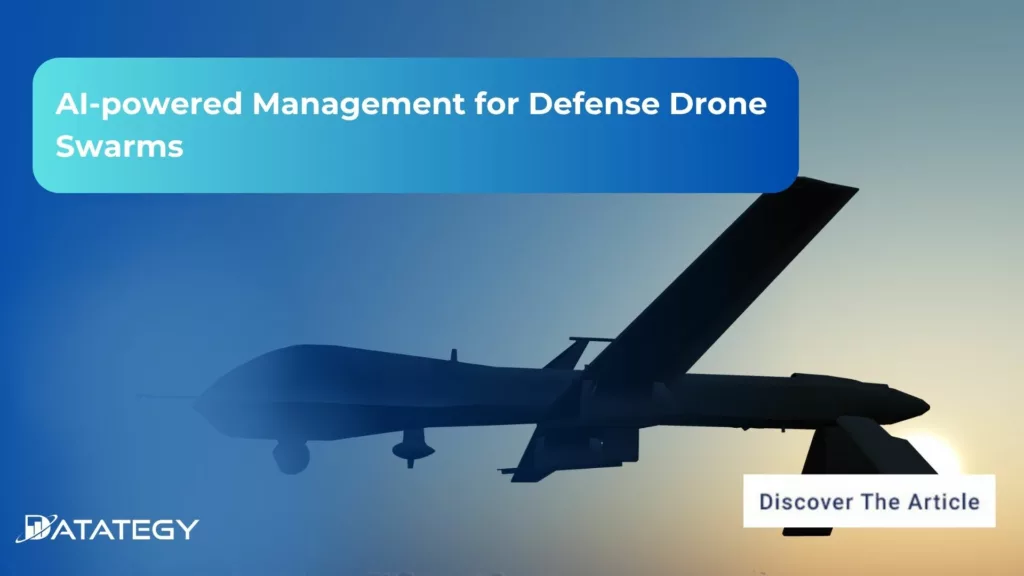
Over 50% of technology patents in the field of drone swarm control have been granted within the past three years, indicating a rapid acceleration in research and development in this area. (GlobalData Technology Foresights).
What does Drone Swarms mean?
Drone swarms consist of pilotless drones (UAVs) that operate as a unified, well-coordinated entity, mimicking the group behavior of insects or birds in nature. Unlike standard drone operations where each drone is controlled separately, drone swarms depend on advanced algorithms and artificial intelligence to communicate, exchange information, and make collective decisions in real time.
This makes it possible for them to cooperate to avoid barriers, adjust to shifting conditions, and carry out difficult tasks with little assistance from humans. The swarm is significantly more resilient and effective in military and defense operations since it can function as a single, dynamic entity as opposed to individual drones.
Drone swarms are very useful in defense scenarios because they may conduct extensive surveillance, overwhelm adversary systems, or carry out coordinated attacks with unmatched accuracy. Each drone in the swarm has a distinct role to perform in the operation, and the others can modify their behavior to keep the goals of the mission intact if one unit malfunctions or is destroyed.
Swarms are extremely resilient in contested contexts where communication with a central controller may be interrupted due to their self-organizing ability. Drone swarms are revolutionizing modern warfare as AI technologies develop, giving armies the capacity to carry out intricate, multi-domain operations at a scale and speed that was previously unthinkable.
What are the Key Advantages Over Traditional UAV Systems
1- Superior Adaptability and Real-Time Coordination
The capacity of drone swarms to instantly adjust to changing battlefield conditions is among its most revolutionary advantages. Conventional UAVs have a limited capacity to respond independently to unanticipated obstacles and necessitate substantial pre-mission programming. Operators must manually act in the event of an unforeseen threat or change in the weather, which could cause response times to be delayed.
Drone swarms use peer-to-peer communication and AI-driven autonomy to address this issue. Sensing its immediate surroundings, each drone works with the swarm to modify flight routes, steer clear of obstructions, or divide up tasks.
During a reconnaissance mission, for instance, if a portion of the swarm notices enemy radar activity, the impacted drones can quickly change their course while the others continue to collect intelligence in other locations. Likewise, during offensive operations, swarms can alter their formation on the fly to get around defenses or overwhelm adversary systems from several angles at once. This degree of flexibility enables intricate manoeuvres that would be impossible with separately piloted UAVs and significantly increases mission success rates.
2- Scalability and Force Multiplication
The potential of drone swarms to scale quickly and function as a real force multiplier is one of their most notable benefits over conventional UAV systems. Conventional UAV operations frequently rely on centralised control, in which each drone is managed separately by a team or a human operator. This raises the operational workload and restricts the number of drones that can be deployed simultaneously in an efficient manner.
Drone swarms, on the other hand, employ distributed systems driven by AI to allow hundreds or even thousands of drones to coordinate on their own. Without depending on a single point of control, each unit interacts with its neighbours, exchanges situational data, and decides how to respond to changes in real time.
Military forces can use swarms for tasks needing extensive coverage, like border patrol, electronic warfare, and wide-area monitoring, thanks to their scalability. Swarms may swiftly cover vast areas, overpowering opponent defenses with their sheer numbers and well-coordinated movements. In order to maintain mission continuity, the swarm’s self-healing algorithms immediately redistribute jobs among remaining drones in the event that one is lost due to enemy action or mechanical failure. A tactical advantage over previous UAV systems, where the loss of a single drone could jeopardise an entire operation, is provided by this redundancy.
3- Cost-Effectiveness and Operational Efficiency
It is frequently more economical to deploy a swarm of smaller, less costly drones rather than depending on a small number of large, complex UAVs. Design, manufacturing, maintenance, and operational support are all expensive for traditional high-value UAVs. Losing one can be a significant financial and strategic loss, making them high-risk investments. Swarm systems, on the other hand, are made up of many inexpensive drones that work together to accomplish mission goals while reducing the significance of each individual drone.
Additionally, this dispersed strategy lowers logistical complexity. Military personnel can use small launch devices to deploy lightweight, portable UAV swarms rather of maintaining and transporting bulky UAV platforms.
Swarms’ autonomy further reduces the need for intensive human supervision, freeing up knowledgeable operators to make more complex decisions. Swarm operations also require less energy and can complete missions more quickly, saving time and resources, because they use AI for route optimisation, resource allocation, and task execution.

At Datategy, we believe that AI is not just enhancing drone capabilities; it’s fundamentally empowering drone swarms to become truly intelligent, adaptive, and decisive forces on the modern battlefield.
Thibaud Ishacian
Head of Product - Datategy
What are the Core Features of AI-Powered Drone Defense
1- Advanced Multi-Sensor Fusion for Robust Detection & Classification
Modern anti‑drone systems must juggle data from radars, RF scanners, cameras, and acoustics—often in complex environments with birds, kites, or interference. AI acts as the central intelligence, seamlessly integrating these disparate data streams to recognize drones with astounding precision. For instance, research shows AI‑enabled surveillance systems improve target detection accuracy by up to 40% compared to traditional methods.
This increased precision is essential because, without smart fusion, systems can misidentify innocuous objects or miss covert drones. Deep learning algorithms, however, are able to identify minute characteristics that set drones apart from harmless objects, such as distinct rotor blade pitches or radio frequencies. As a result of ongoing machine learning, these systems become increasingly intelligent over time, lowering false alarms by adjusting to new drone models and behaviors.
2- Adaptive, Context-Aware Countermeasure Deployment
Not every drone intrusion calls for the same reaction, and AI makes sure that the appropriate reaction is given in each case. AI can dynamically select techniques that eliminate threats while minimising collateral damage when combined with electronic warfare instruments like jammers or spoofers. When properly targeted, soft-kill techniques like RF jamming stop rogue drones without interfering with neighbouring GPS or telecommunications networks.
Furthermore, AI keeps improving its methodology. Performance information (such as the time it takes to turn off a drone or collateral interference) is incorporated into the learning loop following each interaction. Over time, this feedback results in more intelligent strategies. Research in AI anti-drone markets indicates that AI-powered smart jammers have been drastically decreasing needless counteractions and reducing false alerts by 90% (Wikipedia).
In urban or mixed-use settings, this combination of automation and contextual awareness guarantees that anti-drone systems continue to be accurate, effective, and cause the least amount of disturbance to neighbouring systems.
3- Predictive Behavior Analysis from Tabular Logs
Drone flight paths, speed, altitude, timestamps, and control signals are all contained in tabular logs, which are structured data tables. However, because of their sheer number and complexity, they are frequently underutilised in defense situations when used alone. By examining these records to find trends that humans might overlook, AI alters this dynamic. In order to identify anomalies, recurring patterns, and minute variations in flight patterns that might indicate surveillance, reconnaissance, or an impending threat, it uses machine learning to sort through millions of rows.
An AI model might see, for instance, that a drone frequently hovers at particular coordinates for a little longer periods of time during various flights, indicating that the drone is collecting imagery. It is impossible to perform this level of analysis by hand. Studies reveal that, when compared to rule-based systems, AI systems that analyse structured aviation data can increase anomaly detection rates by as much as 65% (MarketsandMarkets). By employing tabular logs as real-time situational tools rather than merely archives, defense teams can respond more quickly and intelligently.
4- Scalable Solutions for Large-Scale Data
Large amounts of structured drone flight data are produced by several locations that are frequently monitored during modern defense operations. Predictive behavior analysis may be scaled across various datasets by AI, guaranteeing thorough coverage without taxing humans or systems.
Terabytes of tabular logs from radar stations, RF sensors, and even crowdsourced observations may be handled by AI platforms like Datategy’s papAI using distributed processing and sophisticated machine learning techniques. This scalability is essential as enemies use autonomous UAVs or drone swarms more frequently. Businesses may analyse up to 50 times as much data while retaining real-time insights when AI is used in military data analytics, according to Deloitte (Deloitte Insights).
Even when monitoring hundreds of drone flights at once, operators can rapidly understand situational awareness thanks to AI-powered dashboards that can display these findings in easily navigable visualisations. This comprehensive approach guarantees that defense systems continue to function well in situations with multiple threats and significant levels of change.
What are the The Role of AI in Drone Swarms Management
1- Fleet Monitoring and Situational Awareness
An operational advantage that conventional systems cannot match is made possible by AI, which is essential in allowing real-time fleet monitoring and situational awareness across drone swarms. Conventional UAV deployments can rapidly become too much for operators to handle, especially when large-scale missions are involved. However, each drone functions as a node in a more extensive, intelligent network as well as a data collector when swarm management is enabled by AI.
Data streams from the swarm’s sensors, including thermal imagery, radar scans, video feeds, and even environmental factors like wind speed or electromagnetic interference, are analysed by machine learning algorithms. AI creates a dynamic, high-resolution map of the battlefield in real time by combining data from all units. Patterns in troop movements are identified, enemy radar or jamming attempts are detected, and anomalies that can point to concealed threats—like ambush zones or camouflaged assets—are flagged on this map.
For instance, if multiple drones identify minute changes in heat signatures across a ridge during a reconnaissance mission, the AI system can compare this information with other data sources, such as shifts in radio frequencies or drone shadow patterns, to identify whether the variation is due to natural terrain fluctuation or a surprise from an enemy vehicle.
2- Predictive Maintenance and Fleet Health Monitoring
AI is important for sustaining the health and preparedness of drone swarms over time, not only for missions. AI-powered predictive maintenance assists in tracking the condition of each fleet unit, spotting any problems before they become failures. In order to identify irregularities and forecast component longevity, machine learning algorithms examine data from onboard sensors, such as engine temperatures, battery levels, vibration patterns, and wear indicators.
Drones’ operational lifespan is increased and downtime is reduced with this proactive maintenance strategy. AI makes it possible to implement a condition-based strategy in which maintenance is carried out only when necessary, as opposed to strict, time-based maintenance schedules (which may result in needless expenses or missing failures). This results in a more robust and economical fleet for defense missions, where preparedness and dependability are critical.
Additionally, if a drone starts to malfunction while in the field, the swarm may instantly reassign jobs and monitor itself in real time, guaranteeing mission continuity. The way drone fleets are handled has changed dramatically as a result of the incorporation of AI into both operational and logistical components.
3- Autonomous Decision-Making in Dynamic Environments
The ability of AI to enable autonomous decision-making in dynamic and frequently hostile contexts is one of the most significant features of AI in drone swarm management. AI-enabled swarms employ deep learning and reinforcement learning to identify patterns and forecast results, in contrast to conventional UAVs that mostly rely on human operators to assess threats or make tactical decisions. Because each drone in the swarm functions as both an autonomous agent and a component of the collective intelligence, they are able to make snap judgments based on data that is updated in real time.
A swarm could, for instance, identify enemy movements or unexpected radar signals in a defense scenario. AI algorithms allow the swarm to decide on the best course of action without waiting for commands, whether it be evasive manoeuvres, regrouping to concentrate surveillance efforts, or dispersing to decrease exposure. This degree of autonomy guarantees quicker reactions to new dangers and lessens the cognitive load on human operators.
Additionally, it creates opportunities for decentralised operations, in which swarms can carry out their tasks even in the event that connectivity with a control centre is interrupted. Armed forces can gain a considerable advantage in speed, flexibility, and resilience by giving AI the task of making tactical decisions.
4- Anomaly Detection in Drone Activity
AI is the key to the success of anomaly detection, which has emerged as a key component of contemporary drone swarm management. Swarms of drones operate independently in complicated surroundings during large-scale defense operations, making it essential to continuously monitor behavior and alert to anything that deviates from expected patterns. Conventional UAV systems frequently use manual oversight or preset thresholds to identify anomalies, which can be laborious and prone to mistakes. But anomaly detection becomes proactive, accurate, and flexible with AI.
By allowing self-corrective behaviors, anomaly detection also improves swarm resilience. The swarm has the ability to remove a drone from the formation and reassign its responsibilities to other drones that are in good health if one begins acting strangely. This keeps the entire mission from being at risk from a single drone going down. Furthermore, AI can continuously improve its detection algorithms to lower false positives and increase accuracy in subsequent missions by learning from each abnormality.
5- Decentralized Control & Coordination
One of the most transformative contributions of AI to drone swarm management is the shift from centralized control systems to fully decentralized architectures. In traditional UAV operations, a central command station acts as the brain, directing every drone’s movements and processing their data.
While effective in controlled environments, this approach introduces a critical vulnerability: a single point of failure. If communication between the drones and the control center is disrupted—due to jamming, hardware failure, or cyberattacks—the entire operation can collapse.
Decentralised control, in which every drone functions as an intelligent actor inside a self-organizing system, is made possible by AI. Each unit processes local sensor data, evaluates its surroundings, and makes decisions in real time using onboard AI algorithms rather of waiting for orders from a central centre. Drones exchange information about hazards, impediments, and mission progress with adjacent units via lateral communication.
Through peer-to-peer communication, a mesh network is created in which intelligence is dispersed across the swarm as opposed to being centralised in one node.
Leading the data revolution: CDO role in today's organizations
The need for CDOs is expanding as a result of the growing significance of data in today’s corporate environment. Any organization’s success depends on the CDO, who is the primary force behind digital innovation and change.

How papAI Enhances AI-powered Management for Defense Drone Swarms
papAI is an advanced AI platform designed to orchestrate complex, data-driven operations with precision and speed. In the context of defense drone swarms, papAI acts as the intelligent backbone that empowers autonomous fleets to operate seamlessly at scale.
It processes massive streams of real-time data, enhances decision-making with predictive analytics, and ensures mission resilience through decentralized yet coordinated control. By integrating papAI, defense organizations can transform raw drone data into actionable insights, enabling faster, smarter, and more secure swarm operations in even the most challenging environments.
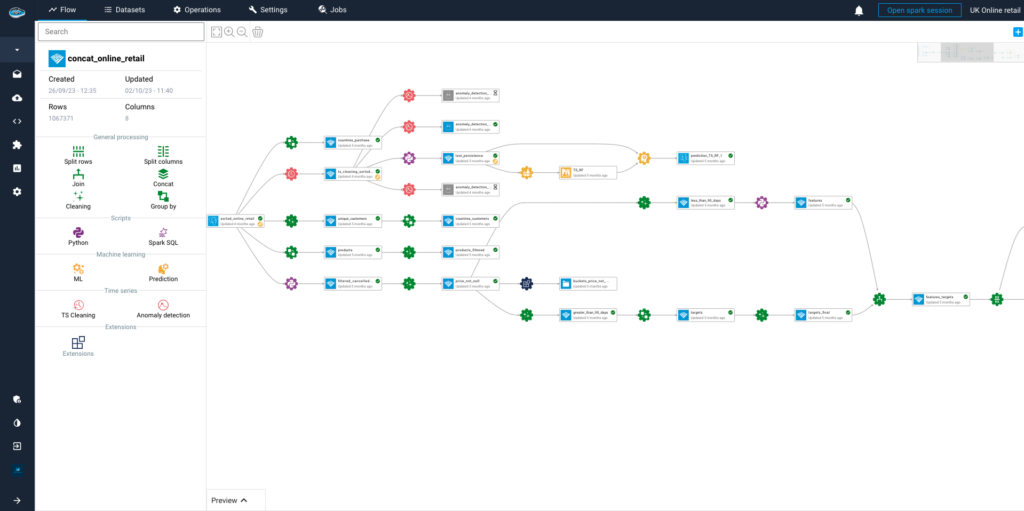
Here’s an in-depth look at the key features and advantages of this innovative solution:
1- Unified Data Processing for Real-Time Insights
By combining vast amounts of data from drone swarms into a single, intelligent platform, papAI enables defense teams. Terabytes of data are produced by drones during swarm operations, ranging from telemetry and environmental readings to video feeds and thermal imaging. Real-time management and interpretation of this deluge of data can be difficult, but papAI’s sophisticated data integration features make it easy. It gives operators a clear, actionable image of the battlefield by instantly gathering, cleaning, and analyzing data from several sources.
Defense teams can monitor swarm activity in great detail, discover trends in adversary movements, and promptly spot abnormalities that can indicate system breakdowns or concealed threats thanks to this unified perspective. papAI converts unprocessed drone data into intelligence that can be used to make decisions, making missions more accurate and faster, whether they are coordinating reconnaissance over large areas or reacting to new threats.
Datategy experts show that integrating AI-powered unified data processing can boost operational efficiency by up to 35%. This means defense teams can process and analyze vast amounts of real-time drone data much faster than before.
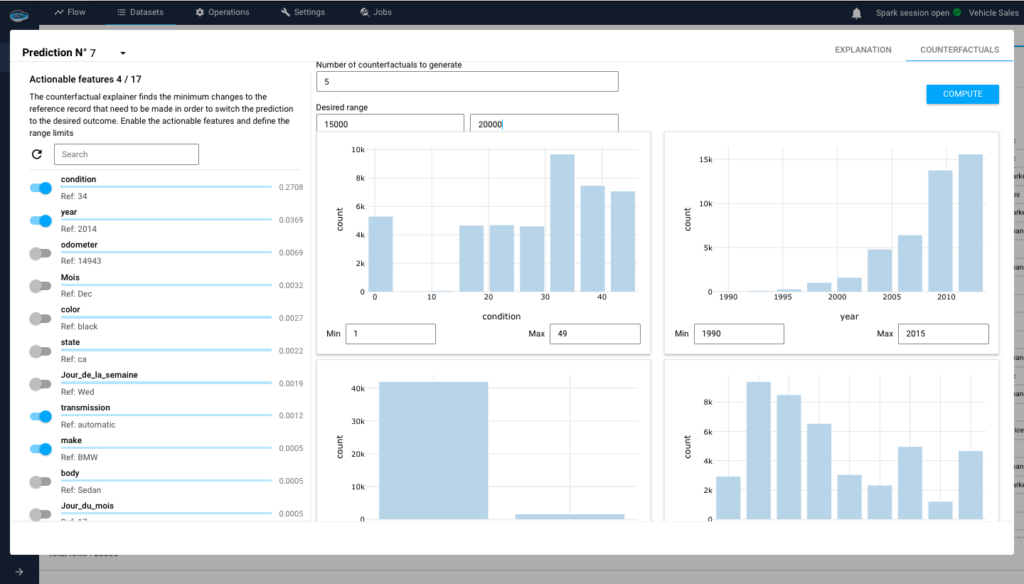
NER/RE machine learning tasks
2- Advanced Predictive Analytics for Fleet Health and Readiness
The capacity of papAI to provide predictive analytics that maintain drone swarms mission-ready is one of its main advantages. Conventional fleet maintenance frequently adheres to strict timetables, which may result in unplanned downtime or unanticipated breakdowns. Defense teams may use papAI to analyse performance indicators like power consumption, engine vibrations, and communication integrity to keep an eye on each drone’s health in real time.
Early warning indicators of mechanical wear, battery deterioration, or sensor problems are detected using papAI’s AI models. This makes it possible to take preventative measures, such as replacing or repairing parts before they break down in the field. In order to maintain operational continuity, papAI assists in dynamically reassigning jobs even during current missions in the event that a drone exhibits indications of underperformance. PapAI increases the dependability and economy of drone swarm operations by prolonging asset lifespans and lowering logistical hazards.
According to Datategy’s AI specialists, implementing advanced predictive analytics can reduce drone fleet downtime by 30%. By continuously monitoring drone health indicators such as battery status and engine performance
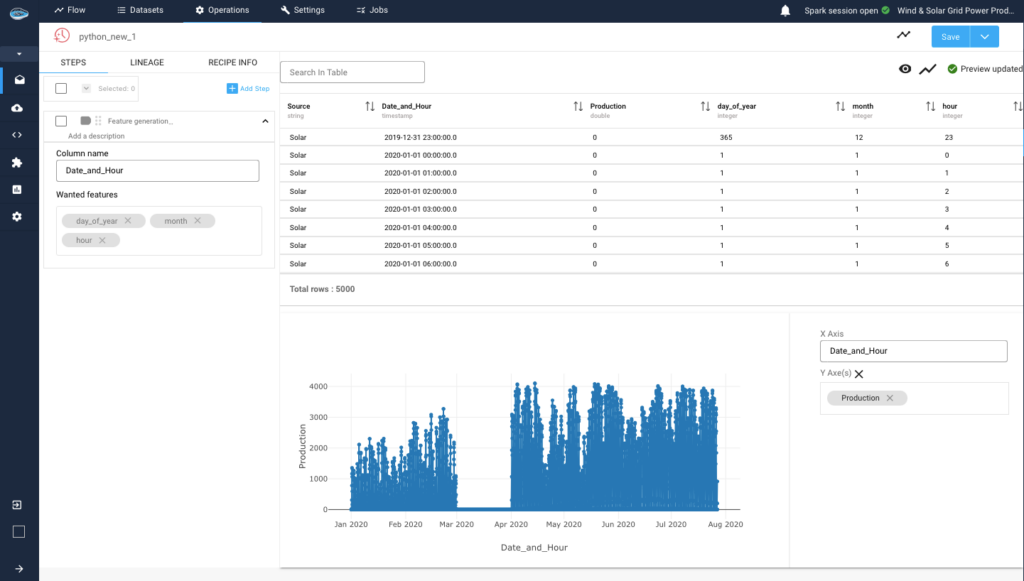
local interpretability of a classifier with feature text
3- Decentralized Control with Central Oversight
Drone swarms run autonomously using decentralised AI algorithms, but papAI offers the crucial supervision required for mission assurance. The platform serves as a strategic command layer that keeps an eye on swarm behavior, verifies decisions made by AI, and allows human operators to step in when needed. By striking a balance between supervision and autonomy, swarm operations are guaranteed to be in line with larger defense goals and mission drift is avoided.
Without endangering actual assets, operators can evaluate swarm responses to possible threats, simulate mission scenarios within papAI, and improve AI models. Even in contested contexts where central control may be partially compromised, the platform enables secure communication and coordination during active deployments. This hybrid strategy maintains human decision-makers firmly in the loop while enhancing operational resiliency.
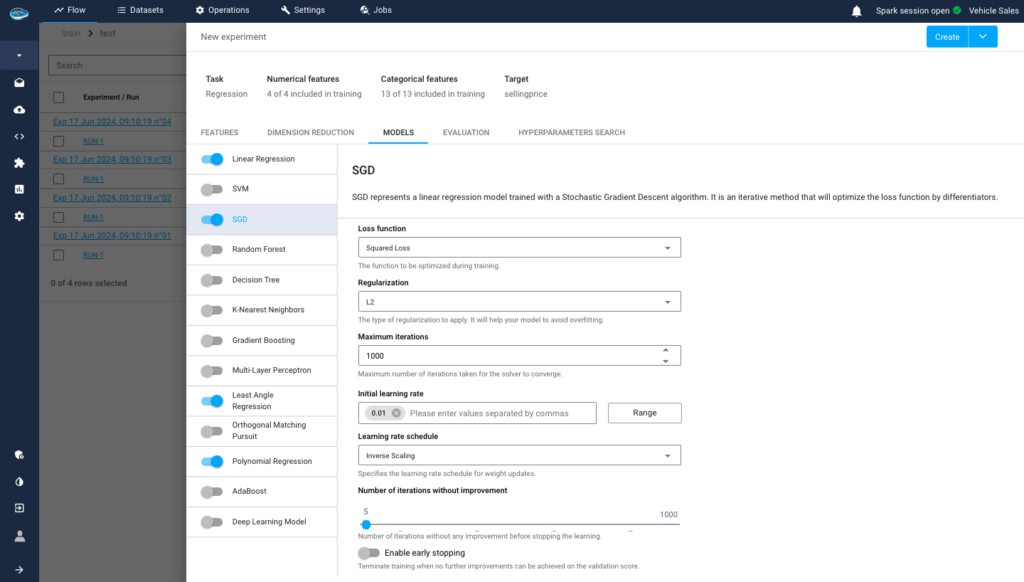
Survival Analysis for Machine Life Prediction
4- Explainable AI for Transparent Decision-Making
Before acting in high-stakes defense situations, operators must comprehend the reasoning behind an AI system’s recommendation. Decisions made by opaque black-box AI systems can erode trust and cause delays in reactions.
papAI’s explainability features help it overcome challenges. When a drone is detected, operators receive clear information about the detection process. This includes which sensors were key in identifying the drone, its flight patterns, and radio frequency signatures.
It also explains why a specific countermeasure is recommended. In both military and civilian defense, this transparency promotes accountability and compliance with regulations. It also builds trust. By combining human judgment with AI accuracy, operators can make informed decisions faster.
Datategy experts reveal that integrating explainable AI (XAI) into defense drone management can improve decision accuracy by 85%. This significant boost arises because XAI helps human operators understand the reasoning behind AI-generated recommendations,
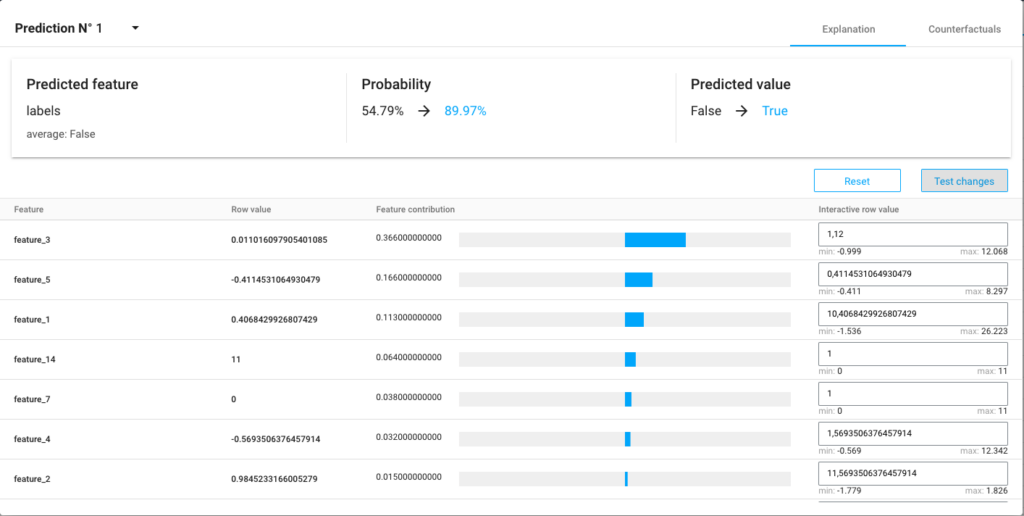
Geospatial analysis from papai
Leverage papAI's AI Capabilities for Advanced Drone Management
Modern defense operations are being redefined by AI-powered drone swarms, which provide unparalleled battlefield scalability, resilience, and precision. However, in order to reach their full potential, organisations require a strong, intelligent platform that can handle the intricacies of autonomous decision-making, data fusion, and real-time coordination.
Here’s where papAI comes into play. papAI guarantees that your drone swarms are not just operational but also mission-optimized by offering decentralized control supervision, predictive maintenance capabilities, and powerful analytics.
Book a demo today with a Datategy AI expert and discover the power of intelligent swarm management in action.
Drone swarms are collections of drones without pilots (UAVs) that function as a single, highly coordinated unit, simulating the collective behaviour of insects or birds in the wild. Drone swarms rely on sophisticated algorithms and artificial intelligence to interact, share data, and make choices as a group in real time, in contrast to typical drone operations, where each unit is operated independently.
AI enables drone swarms to operate autonomously at scale, processing real-time data, optimizing flight paths, and coordinating complex missions without relying on constant human control. It allows swarms to adapt instantly to dynamic environments, avoid obstacles, and even respond to threats with split-second decision-making—capabilities traditional UAV systems simply can’t match.
Drone swarms can deploy electronic countermeasures to disrupt enemy communications, radar, and sensor systems. AI helps the swarm to detect electronic threats, adapt tactics on the fly, and coordinate jamming activities, enhancing battlefield control without exposing manned assets to risk.
Interested in discovering papAI?
Watch our platform in action now
AI’s Role in Translating Complex Defence Documentation
AI’s Role in Translating Complex Defence Documentation The defence sector...
Read MoreHow AI Transforms Technical Documentation in Medical Devices and Life Sciences
How AI Transforms Technical Documentation in Medical Devices and Life...
Read MoreDatategy and Alpha X Join Forces to Strengthen AI-Driven Governance Across EMEA
Datategy and Alpha X Join Forces to Strengthen AI-Driven Governance...
Read More